La Brède, Gironde, Nouvelle-Aquitaine 作者: 来源: 发布时间:2021-09-24
I.Population and Area
Total Area: 23.28 km2
Population in 2017: 4 280
Population Density: 184 /km2
Histogram of demographic change
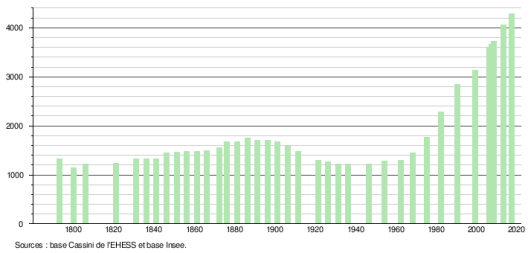
II.Natural Geography (environment and resources)
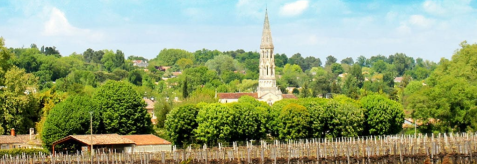
The town is located on the Saucats river, 18 km south of Bordeaux.
The neighboring towns are Saint-Médard-d'Eyrans to the north, Ayguemorte-les-Graves to the north-east, Saint-Selve to the east, Saint-Morillon to the south, Saucats to the south-west, Léognan to the extreme west for about 120 meters and Martillac to the north-west.
About twenty kilometers south of Bordeaux, La Brède stretches along the edge of the Gironde forest. It is particularly served by the A 62 motorway, a major element of its great residential appeal.
Its landscapes stretch along the Saucats valley, a tributary of the Garonne. They have two characteristics: the open countryside of the Graves vineyard (classified as AOC Graves) and the beginnings of the Landes forest. Border between the urban world of a large metropolis and a rural area with a strong character, La Brède offers its inhabitants an exceptional quality of life.
Communication routes and transport:
The A62 motorway (Bordeaux-Toulouse) can be reached by access no 1.1, called de La Brède.
Lines 502 (Talence Peixotto - La Brède) and 515 (Saint-Médard-d'Eyrans-Gare TER - La Brède) of the TransGironde buses serve the town.
TransGironde Proximity
An appointment with the doctor, a train to catch, shopping at the supermarket… Transgironde proximity is a transport service on demand offered by the Department of Gironde in partnership with the Community of Communes of Montesquieu.
The on-demand transport network allows all isolated people (seniors over 75, people with reduced mobility or loss of autonomy, people with minimum social benefits or in professional integration) to move more easily.
To benefit from it is very simple, you just have to send your registration request to the CCM. Then once your registration has been validated, the trip can be booked by telephone 48 hours in advance.
Sources : https://www.labrede-montesquieu.fr/la-ville/presentation/
https://www.labrede-montesquieu.fr/cadre-de-vie/transport/
III.Economy
Employment rate (%): 75.4 (2017)
Poverty rate by age group of the tax advisor(%): 6 (2017)
Average employment income (€):3 065 net per month (36 782 net per year)(2014)
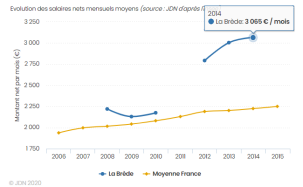
Evolution of average monthly net wages
Sources : http://www.journaldunet.com/business/salaire/la-brede/ville-33213
https://www.insee.fr/fr/statistiques/2011101?geo=COM-33213#chiffre-cle-8
IV.Industrial Characterisitics
An important artisanal zone, known as the Prade, is located on the territory of the municipality:
The La Prade business area
Located at the exit of Saint Médard d´Eyrans, in the direction of La Brède. It is reached by interchange 1.1 of the A62 motorway and also by the RD 1113 towards La Brède.
This area covers an area of 235,000 m2. The economic development, planning, maintenance and management of this area is the responsibility of the Community of Communes of Montesquieu.
The dynamism of a municipality is also measured by its local economic fabric.
La Brède is one of those municipalities where the plurality of the offer in terms of services, retail shops, health professions but also industrial activities, contributes to its demographic and urban development and increases its power of attractiveness for future residents of Brédois, as for job seekers in the sector.
The municipality's policy has always been to rely on a strong, plural and federated economic fabric to meet everyone's demand in terms of consumption but also to constitute a bulwark against desertification which threatens certain rural municipalities which have not been able to avoid the gradual closure of their businesses.
Economic dynamism feeds on demographic dynamism and vice versa!
La Brède takes care to respect this precious balance for the comfort of all.
The Brédoise economy relies on around 120 professional craftsmen, traders, liberal and independent professions, personal assistance associations and winegrowers who fall into six or seven main categories:
1)Health
2)The “food” professions
3)The professions of "equipment and human well-being"
4)Building and renovation trades & services
Graves terroir
Between the Landes forest and the Garonne valley, the Graves terroir draws its character and its difference from the multitude of gravel, pebbles, silica and limestone rolled up by the water, dispersed over the millennia by the great floods of the river.
Set in hilly terrain, the Graves vineyards benefit for the most part from excellent exposure, with slopes still steep enough to ensure remarkable natural drainage reinforced by an important hydrographic network of small tributary rivers of the Garonne.
Since the end of the 18th century, the forest of the Gironde moors, born from the desire to drain the Landes marshes by massive planting of pines, has protected the Graves terroir. Its climate, temperate and favorable to the vines by its mildness and regular humidity, is influenced by the nearby ocean.
It is all these characteristics that make this poor soil, which no other culture than the vine or the woods would like, gives the wine so typical of Graves, the only wine in France to bear the name of its soil: "las Grabas de Bordeus "," The Graves of Bordeaux ".
Sources:https://www.saint-medard-deyrans.fr/votre-village/vie-economique/zones-dactivites/
https://www.labrede-montesquieu.fr/cadre-de-vie/vie-economique/
https://www.labrede-montesquieu.fr/cadre-de-vie/vie-economique/leconomie-locale/
https://www.labrede-montesquieu.fr/la-ville/terroir-des-graves/
V.Attractions
1. The Castle of La Brède
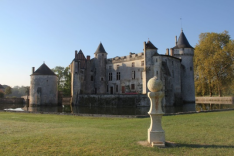
Its origins date back to the 11th century when the La Lande family appeared in La Brède.
In 1404, Pope Boniface IX authorized the construction of a new chapel, adjoining the keep.
In 1419, the castle was remodeled to give it its current appearance with its large keep, the three drawbridges and its large moat in three successive ditches.
The castle entered the Montesquieu family in 1686, brought as a dowry by Marie Françoise de Pesnel during her marriage to Jacques de Secondat. It is in this place that, on January 18, 1689, Charles Louis de Secondat, future baron de La Brède and de Montesquieu, was born. The tomb of his parents is behind the altar of the church of Saint Jean d´Etampes.
Montesquieu on his land
On the death of his father, Montesquieu inherited the family barony, including the Château de La Brède. Very attached to him, " this butterfly that I stripped of its nymphs", he often talks about it to his friends in his correspondence: "it is the most beautiful country place that I know. " you would tell me about all of Europe, I would tell you about my village of La Brède ".
The philosopher enriched the library all his life. Thousands of books were kept in the vast Guard Room of the castle. They completed the already rich collection of his father. Two public sales took place (1926 and 1939).
Nowadays
In 1994, Jacqueline de Chabannes, last resident of the castle and one of the descendants of Denyse, youngest daughter of Montesquieu, donated the remaining books and family archives to the Municipal Library of Bordeaux.
At the end of her life, Mme de Chabannes created a Foundation so that the castle would be preserved and still serve as a setting for the evocation of the philosopher (2004).
2.The Church of Saint Jean d'Etampes
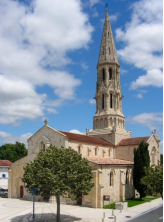
It is the oldest building in the Municipality. Dedicated to Saint John of Etampes or of Estampes, it owes its name to the presence in the parish of a Templar installation on the site of one of the oldest houses in the village.
Following the ravages of time, the monument was reconstructed in neo-Romanesque style by the architect Gustave Alaux, friend and disciple of Viollet Le Duc between 1854 and 1864.
Remains of the original building the facade of the nave and the central portal of Saintonge Romanesque style, which date from the 11th century. Note the magnificent modillions of the portal.
The restoration carried out by the Municipality between 2000 and 2003 underlines the beauty of the ensemble in the heart of the old town.
The tetramorph
The Church of La Brède is recognized for its tetramorph, a Romanesque representation of the four evangelists around Christ in Majesty (usually found on the tympanum of the portals) inspired by the vision of Ezekiel, transcribed by Saint John in the Apocalypse.
Of all the representations of the tetramorph already found on the architect's other bell towers, these are the most imposing and the lowest, at 13 m high. The order indicated by Saint John in the Apocalypse is respected, the phylacteries held by the evangelists are still visible.
The praying virgin
This 11th century medieval statue was discovered in 2003 in the foundations of the facade of the left aisle of the church, during the renovation of the building.
It came in two main pieces, and nineteen other pieces ranging from 18 cm long for the largest to 2.5 cm for the smallest.
In 2004, the DRAC services granted a subsidy for its restoration and included this statue in the supplementary inventory of historical monuments. Several centuries later this statue found its place in the church.
3.The Saucats-La Brède geological nature reserve
The Saucats-La Brède Nature Reserve, extending over nearly 75 hectares, is located in the Aquitaine sedimentary basin: the sea left there, 20 million years ago, deposits of sediments containing very many fossils. Outcrops are visible on the banks of two streams: the Saucats and the Brousteyrot, its tributary.
The geological reserve is made up of 3 geographic sectors in the municipalities of Saucats and La Brède. The forest trails of the reserve, marked with explanatory panels, offer a pleasant walk back in time, discovering the sites of the Bernachon mill, Ariey, Pont-Pourquey, Lassime, Bourasse, Péloua ...
In the heart of the forest, thousands of fossils approximately 20 million years old await visitors in their open-air windows. Giant shark teeth, corals and other fossilized mollusks can be discovered during guided tours organized by the Maison de la Réserve.
Since 1982, the site has enjoyed the protective status of “National Nature Reserve”, thus constituting the first geological nature reserve created on French territory.
The association managing the Reserve, made up of geological specialists, qualified personalities, researchers and the local communities concerned, has been pursuing the general objective of protecting the site's geological heritage since 1982 but also its opening to the public with a strong educational and scientific dimension. . Seven developed sites were created between 1989 and 2008 and host many schools and scientists.
Sources : https://www.labrede-montesquieu.fr/la-ville/patrimoine/le-chateau-de-la-brede/
https://www.labrede-montesquieu.fr/la-ville/patrimoine/leglise-saint-jean-detampes/
https://www.labrede-montesquieu.fr/la-ville/patrimoine/la-reserve-naturelle-geologique-de-saucats-la-brede/
VI.History
For the situation of the town in the eighteenth century, see the work of Jacques Baurein.
During the Revolution, the parish of Saint-Jean de Labrède (or Étampes) formed the town of Labrède. On July 6, 1987, the town of Labrède became La Brède.
In 1875, Mme de la Roche, a traveler passing through La Brède, described a fair day in these terms:
“There were all kinds of colored handkerchiefs from factories in Béarn, homeland of Henri IV. Women use it to cover their headdresses (…). All those who go away carrying a burden on their heads knit, as do all those we see sitting on their donkeys in the middle of baskets of vegetables or those occupied in the fields tending goats, geese and the cows… (…) Many young peasant women wore black skirts with red blouses. (…) Baskets full of crackers, gingerbread and marzipan were circulating in the crowd and around the theater. The trees were all wrapped. The young people talked cheerfully among themselves, but had a very good demeanor; most were very well built. (…) All the people speak a double language, half French, half Gascon. This one is extremely pleasing to the ear. All of them also have something that pleases in their ways and in their way of being. At the inn we had lunch in a room next to which there was another with three tables full of peasants eating grilled fish, salad and cakes. Their conversation, although very animated, remained friendly. The wine made them happy, but not noisy or rude. (…) "
The urbanization of the town took place slowly and has not forgotten Montesquieu to whom a monument was dedicated in 1938.
The war memorial built in 1922 was moved around 1969;
The old schools dating from 1890 were built by the Bordeaux architect Follat;
The Romanesque church was restored by Gustave Alaux.
VII.Other information
Feria
Since 1999, the Municipality of La Brède has organized every year, as part of the Fêtes de la Rosière, bullfighting events that attract a large audience from all over the great southwest of France and beyond, giving the local festival the character of a real feria, in the purest tradition of the southwest.
The last weekend of June, the local festival combines the tradition of the crowning of the Rosière and bullfighting shows: a big bullfight is organized every year in real mobile arenas set up for the occasion. Usually there is also a novillada (fight between young bullfighters and young bullfighters), but also Landes cow games (toro-swimming pool, cockade ...), all accompanied as it should by famous bandas who enliven the streets and the streets. arenas.
These highlights are also an opportunity to welcome delegations from Viana, the Spanish twin city of La Brède.
The Days of La Brède
By bringing together "the Conversations of La Brède", "Montesquieu et Nous" and "the Book Fair", the municipal team wanted an event dedicated to Culture, History and of course to our Brédois philosopher.
But through the choice of the 2019 theme "Slavery: History, memory & current affairs", their desire was also to raise awareness and offer a place of speech and exchange as explained to us by Michel Dufranc "What interested is of course the past; but it is also the fact that we can place ourselves in current society and its new forms of slavery or the welcome we reserve for foreign populations. "
The challenge was successfully met for this edition of the Journées de La Brède: for three days, the public was there. Round tables, exhibition, readings, plays, book fair, concerts, literary award ceremony followed one another in good humor and effervescence at the Château de La Brède farm.
Spring of artists
This brand new fair is a biennial event that showcases the art of painting and sculpture in the form of an Art Gallery at the Salle des Fêtes Montesquieu in La Brède.
Registration
Le Printemps des Artistes is a show intended exclusively for painters and sculptors. It is a biennial event.
Its first edition took place in March 2018, the next meeting should be in March 2020 but due to the municipal elections it will certainly be postponed to 2021.
Sources: https://www.labrede-montesquieu.fr/evenements/feria/
https://www.labrede-montesquieu.fr/evenements/les-journees-de-la-brede/
https://www.labrede-montesquieu.fr/evenements/printemps-des-artistes/
VIII.Contact information
Canéjan town hall address :
1, Place Saint Jean d'Etampes
BP 30047
33652 LA BREDE CEDEX
Mayor : Michel Dufranc (Mandate : 2014-2020)
Mail: contact@labrede-montesquieu.com
Phone number: 05 57 97 18 58
Fax: 05 57 97 18 50
Website: https://www.labrede-montesquieu.fr/
Sources : https://www.labrede-montesquieu.fr/
